WW1 medals and souvenirs grouping
Pfc. Charles J. Clark - Hq Company, 323rd Field Artillery Regiment
Original WWI grouping named to Charles J. Clark, a Private First Class of HQ Company, 323rd Field Artillery, AEF which was part of the 83rd Division during World War One. The grouping includes a Verdun medal and certificate, a French croix de guerre and an Iron cross with the original hand-cut box in which it was send home.
The history of the 323rd Regiment of Light Field Artillery begins on August 29, 1917, when seventy-five officers, commissioned at the first Officers' Training Camp at Fort Benjamin Harrison, Ind., reported at Camp Sherman, Chillicothe, Ohio, to form the nucleus around which the Regiment was later organized. According to the plans for the organization of the National Army, this unit was a part of the 158th Field Artillery Brigade, 83rd Division. The latter was under the command of Major General Edwin F. Glenn, who had been at the head of the Officers' Training Camp at Fort Benjamin Harrison.
Private First Class Charles John Clark
Private First Class
Charles John Clark

Private First Class Charles John Clark
Charles J. Clark was born on November 1, 1895, in Youngstown, Ohio to Homer Clark and Hattie Maude Chamberlin Clark. At 21 years old, he enlisted in the Army (#1954230) on October 3, 1917 in Rochester, Pennsylvania and was assigned to Battery E, 323rd Field Artillery Battalion. Clark stayed with them until November 26, 1917, when he was assigned to Supply Company of the 323rd FA with which he remained until February 18, 1919. Finally he was assigned to HQ Company of the 323rd FA and remained with this unit for the remainder of his army career earning a promotion to Private First Class in January, 1918. He arrived in France with Supply Company on June 10, 1918 and fought with the 323rd FA in the Meuse-Argonne campaign. After the end of World War One he was with the Army of Occupation until May 13, 1919 when he returned to the US where was honorably discharged on May 27, 1919 at Camp Dix, New Jersey.
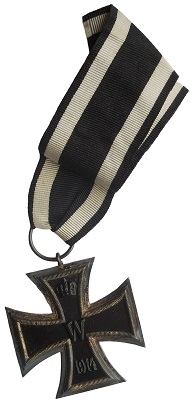
German Iron Cross 2nd Class
This 'Eisernes Kreuz 1914 2de Klasse' was purchased by Pfc. Clark while on leave in Coblenz, Germany. He used a cigar box to sculpt a custom-made box for the medal to send it home to his sister, adding a letter explaining the origins of the medal as well. Today, the medal is still kept in the same box Pfc. Clark handmade 100 years ago. It retains its original ribbon and both the medal and ribbon are in very good condition.
The origin of the Iron Cross lies in the Prussian kingdom and the medal was reinstituted by Emperor Wilhelm at the start of World War 1. The 1914 Iron Cross had three grades: 2nd class, 1st class and the Grand Cross of the Iron Cross. The latter was only awarded to General officers. Both other classes were awarded without regard to rank and by the War's end several million Iron Crosses 2nd Class had been awarded.
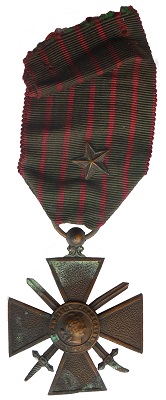
French Croix de Guerre
Original French Croix de Guerre awarded to Charles Clark. On 8 April 1915 a law established the Croix de Guerre to "commemorate individual citations for acts of bravery since the first day of the 1914-1915 war".
The obverse features a medallion in the centre of the cross with a "Marianne" head wearing a Phrygian cap. It is decorated with a laurel wreath and has the words "République Française". The reverse side bears the year 1914 along with the year in which the medal was struck (1915, 1916, 1917 or 1918). In this case 1914-1918. A bronze star symbolised a regiment or brigade citation, a silver star a division citation and silver-gilt star an army corps citation.
German Iron Cross 2nd Class
This 'Eisernes Kreuz 1914 2de Klasse' was purchased by Pfc. Clark while on leave in Coblenz, Germany. He used a cigar box to sculpt a custom-made box for the medal to send it home to his sister, adding a letter explaining the origins of the medal as well. Today, the medal is still kept in the same box Pfc. Clark handmade 100 years ago. It retains its original ribbon and both the medal and ribbon are in very good condition.
The origin of the Iron Cross lies in the Prussian kingdom and the medal was reinstituted by Emperor Wilhelm at the start of World War 1. The 1914 Iron Cross had three grades: 2nd class, 1st class and the Grand Cross of the Iron Cross. The latter was only awarded to General officers. Both other classes were awarded without regard to rank and by the War's end several million Iron Crosses 2nd Class had been awarded.
French Croix de Guerre
Original French Croix de Guerre awarded to Charles Clark. On 8 April 1915 a law established the Croix de Guerre to "commemorate individual citations for acts of bravery since the first day of the 1914-1915 war".
The obverse features a medallion in the centre of the cross with a "Marianne" head wearing a Phrygian cap. It is decorated with a laurel wreath and has the words "République Française". The reverse side bears the year 1914 along with the year in which the medal was struck (1915, 1916, 1917 or 1918). In this case 1914-1918. A bronze star symbolised a regiment or brigade citation, a silver star a division citation and silver-gilt star an army corps citation.
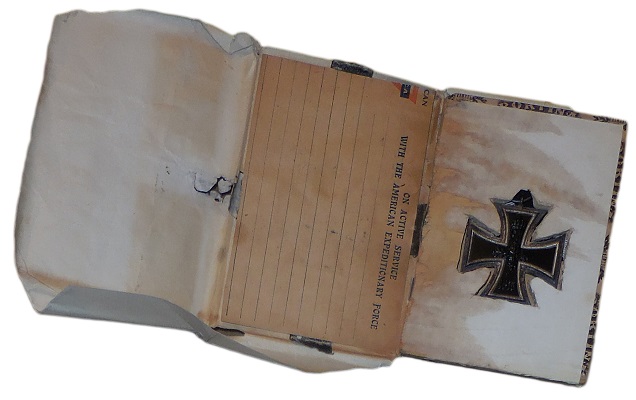
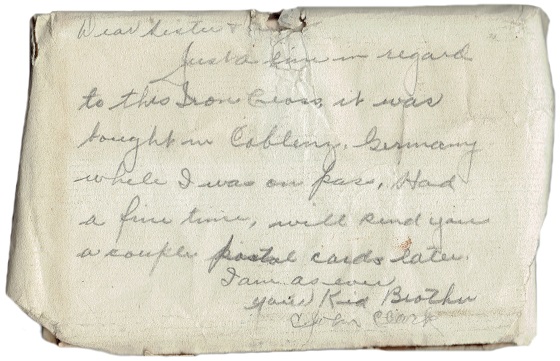
Verdun Medal
The Médaille de Verdun designed by S.E. Vernier, France, 1916 was an unofficial medal created to commemorate the heroism of Verdun's defenders. Originally intended to be "awarded to those who served on the Verdun front between 21 February 1916 and 2 November 1916, the medal was, in fact, awarded to all those who served anywhere on the Argonne and St Mihiel sectors between 31 July 1914 and 11 November 1918. The obverse features the Bust of Marianne, the national emblem of the French Republic, facing right. She wears a helmet and holds a sword. Text reads: 'ON NE PASSE PAS' (They Shall not Pass). The reverse has the Twin towered Porte Chausee in Verdun framed by laurel leaves. Text reads: 'VERDUN 21 FEVRIER 1916'.
The Verdun Medal came with a certificate (see below) and accompanying letter from the Association that issued the award. Luckily, all three were well kept together. The French letter reads: Following your application I have the honor to inform you that I can send you today the Médaille de Verdun; you find enclosed the diploma which certifies that your name has been written in the Golden Book of Verdun soldiers.

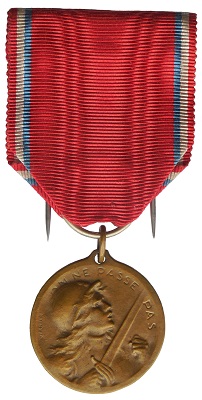
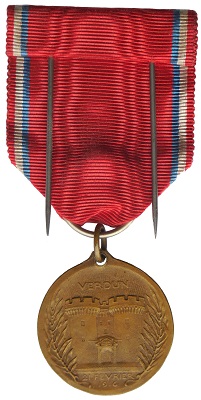
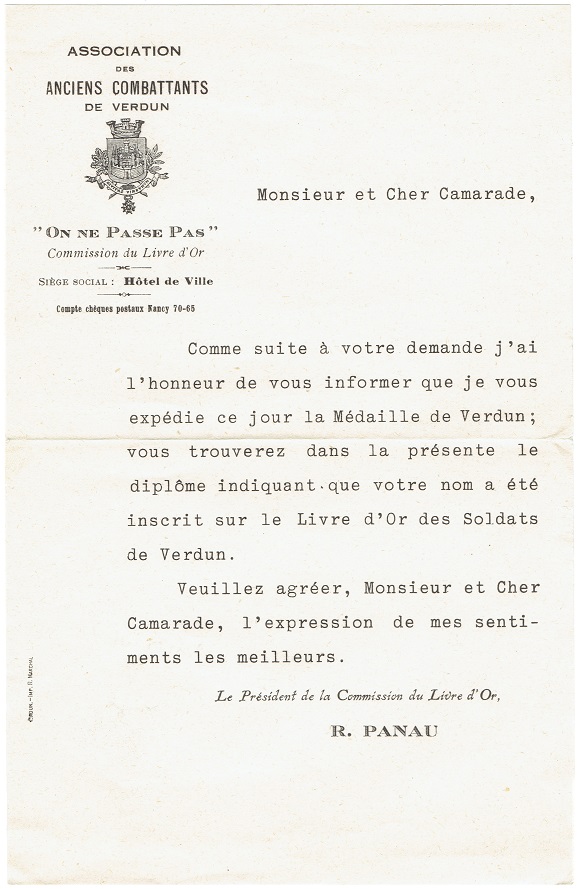
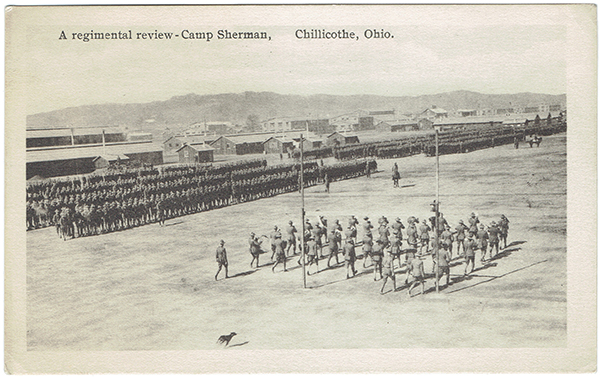
souvenir postcard from Camp Sherman, Ohio